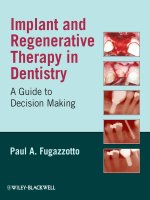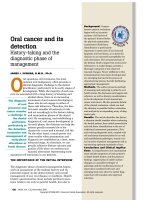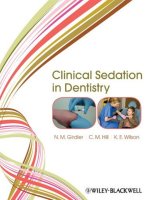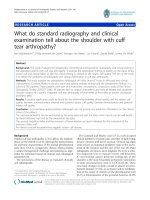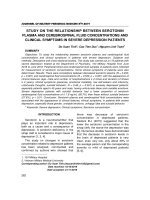Ebook History taking and clinical examination in dentistry: Part 1
Bạn đang xem bản rút gọn của tài liệu. Xem và tải ngay bản đầy đủ của tài liệu tại đây (12.88 MB, 178 trang )
History Taking and
Clinical Examination in
DENTISTRY
History Taking and
Clinical Examination in
DENTISTRY
Charu M Marya
BDS MDS PhD
Professor and Head
Department of Public Health Dentistry
Sudha Rustagi College of Dental Sciences and Research
Faridabad, Haryana, India
Foreword
Rahul J Hegde
The Health Sciences Publishers
New Delhi | London | Philadelphia | Panama
Jaypee Brothers Medical Publishers (P) Ltd
Jaypee-Highlights Medical Publishers Inc
City of Knowledge, Bld. 237, Clayton
Panama City, Panama
Phone: +1 507-301-0496
Fax: +1 507-301-0499
Email:
Suite 835, Philadelphia, PA 19106, USA
Jaypee Brothers Medical Publishers (P) Ltd
17/1-B Babar Road, Block-B, Shaymali
Mohammadpur, Dhaka-1207
Bangladesh
Mobile: +08801912003485
Email:
Jaypee Brothers Medical Publishers (P) Ltd
Bhotahity, Kathmandu, Nepal
Phone: +977-9741283608
Email:
Website: www.jaypeebrothers.com
Website: www.jaypeedigital.com
© 2014, Jaypee Brothers Medical Publishers
The views and opinions expressed in this book are solely those of the original contributor(s)/author(s) and
do not necessarily represent those of editor(s) of the book.
All rights reserved. No part of this publication may be reproduced, stored or transmitted in any form or by
any means, electronic, mechanical, photocopying, recording or otherwise, without the prior permission in
writing of the publishers.
All brand names and product names used in this book are trade names, service marks, trademarks or registered trademarks of their respective owners. The publisher is not associated with any product or vendor
mentioned in this book.
Medical knowledge and practice change constantly. This book is designed to provide accurate, authoritative
information about the subject matter in question. However, readers are advised to check the most current information available on procedures included and check information from the manufacturer of each product to
be administered, to verify the recommended dose, formula, method and duration of administration, adverse
effects and contraindications. It is the responsibility of the practitioner to take all appropriate safety precautions. Neither the publisher nor the author(s)/editor(s) assume any liability for any injury and/or damage to
persons or property arising from or related to use of material in this book.
This book is sold on the understanding that the publisher is not engaged in providing professional medical
services. If such advice or services are required, the services of a competent medical professional should
be sought.
Every effort has been made where necessary to contact holders of copyright to obtain permission to reproduce copyright material. If any have been inadvertently overlooked, the publisher will be pleased to make
the necessary arrangements at the first opportunity.
Inquiries for bulk sales may be solicited at:
History Taking and Clinical Examination in Dentistry
First Edition: 2014
ISBN 978-93-5152-393-2
Printed at
Dedication
I would like to thank my wife Dr Vandana for standing beside
me throughout my career and writing this book. She has
been my inspiration and motivation for continuing to
improve my knowledge and move my career forward.
She is my rock, and I dedicate this book to her.
Contributors
Anil Gupta
MDS
Professor and Head
Department of Pedodontics
SGT Dental College, Hospital and
Research Institute
Gurgaon, Haryana, India
Anirban Chatterjee
MDS PhD
Professor and Head
Department of Periodontology
and Implantology
Oxford Dental College
Bengaluru, Karnataka, India
Avinash J
MDS
Professor and Head
Department of Public Health
Dentistry
Kalinga Institute of Dental
Sciences
Bhubaneswar, Odisha, India
Bhumija Gupta
BDS AEGD GPR
Clinical Faculty
Eastman Institute for Oral Health
University of Rochester
Rochester, New York, USA
Gaurav Sharma
MDS
Reader
Department of Oral Medicine
and Radiology
Sudha Rustagi College of
Dental Sciences and Research
Faridabad, Haryana, India
Hind Pal Bhatia
MDS
Professor and Head
Department of Pedodontics
Manav Rachna Dental College
Faridabad, Haryana
India
Navin Anand Ingle
MDS
Professor and Head
Department of Public Health
Dentistry
KD Dental College and Hospital
Mathura, Uttar Pradesh
India
Pradeep Tangade
MDS
Professor and Head
Department of Public Health
Dentistry
Kothiwal Dental College and
Research Centre
Moradabad, Uttar Pradesh
India
Rajendra Gowda Patil
MDS
Professor and Head
Department of Oral Medicine
and Radiology
Kothiwal Dental College and
Research Centre
Moradabad, Uttar Pradesh
India
viii History Taking and Clinical Examination in Dentistry
SM Kotrashetti
MDS
Professor
Department of Oral and
Maxillofacial Surgery
KLE VK Institute of
Dental Sciences
Belgaum, Karnataka, India
Vandana Dahiya
MDS
Department of Conservative
Dentistry and Endodontics
Haryana Civil Medical Services
Faridabad, Haryana
India
Foreword
It gives me great pleasure to write a foreword for History Taking and
Clinical Examination in Dentistry. The approach adopted by the author
should be a great help to those taking history and doing examination
for diagnosis and treatment planning in dentistry. The idea of taking
symptom complexes and then describing the diagnostic possibilities
with guides to the management both of the disease itself and of the
symptoms will be valuable to all who have to deal with problems of
this sort.
I hope that it will be valuable to all those who have to deal with the
clinical differential diagnosis. It should be of particular use to teaching
faculty, undergraduate and postgraduate dental students and dental
practitioners. It is the sort of book that should be in the hands of
students of dentistry entering the clinics during their clinical postings.
Rahul J Hegde
(Executive Member, Dental Council of India)
Vice-Principal, Professor and Head
Department of Pediatric Dentistry
Bharati Vidyapeeth University Dental College
Navi Mumbai, Maharashtra, India
President, Indian Society of Pediatric Dentistry
Senate Member, Maharashtra University of Health Sciences
Preface
The most important core skills for dental students to master are
history taking and clinical examination. This book has been written
with the philosophy that the acquisition of clinical skills is most
effectively undertaken at the chairside. This book should be used as
a companion, to be taken in the clinics where the information is most
needed. The book begins with a system of history taking followed by
chapters covering clinical examination and diagnosis. Each stage of
the examination starts with a detailed step-by-step description of the
examination method complemented by relevant illustrations, diagrams
and tables. This book is intended primarily for use at the outset of
clinical training; once students have achieved proficiency in the basic
skills of interviewing and examining, the book should also prove useful
for revision.
This book was written keeping in mind the problems faced in clinics
by undergraduate and postgraduate students regarding history taking,
clinical examination, diagnosis and treatment planning as no book is
available in the market focusing specifically on these topics.
Charu M Marya
Acknowledgments
I would like to express my gratitude to many people who provided
support, read, wrote, offered comments, allowed me to quote their
remarks and assisted in the editing, proofreading and design.
I would like to thank my parents for allowing me to follow my
ambitions throughout my childhood. Ever indebted to my mother
for her encouragement and my father, my guide. My brother Dr Kirti
Mohan Marya for standing by me always and sister Dr Priya Nagpal for
her prayers. I also thank my wonderful children: Akshat and Dewang for
always making me smile. My family, including my in-laws, have always
supported me throughout my career and authoring this book and
I really appreciate it. I want to acknowledge my family’s contribution,
for putting up with my absences, both mental and physical.
Many persons generously gave their time in the preparation
of the first of its kind book History Taking and Clinical Examination
in Dentistry. I would like to convey my grateful thanks to all the
contributors for their cooperation and enthusiasm for the publication
of this book. In addition, special appreciation is to be mentioned for
Dr Ruchi Nagpal, Dr Sukhvinder, Dr Amit Rekhi who provided high
quality logistic and editing support during the preparation of this book.
My thanks also go to my colleagues at the Sudha Rustagi College
of Dental Sciences and Research, Faridabad (Haryana), who have given
encouragement and support at key times in the development of this
book and have contributed for creating a stimulating and congenial
environment for me to work.
I would like to thank Mr Dharamvir Gupta (Chairman), Mr Deepak
Gupta (Secretary), Prof (Dr) Indushekar (Principal) and Dr Vishal
Juneja (CEO), Sudha Rustagi College of Dental Sciences and Research,
Faridabad for their encouragement and support in this venture.
xiv History Taking and Clinical Examination in Dentistry
My due regards to Shri Jitendar P Vij (Group Chairman), Mr Ankit
Vij (Group President) and Mr Tarun Duneja (Director–Publishing) of
M/s Jaypee Brothers Medical Publishers (P) Ltd, New Delhi, India, for
rendering help to come out with this publication in time. I am thankful
to Mrs Samina Khan (Executive Assistant to Director–Publishing), for
being so instrumental and helpful for this publication, and Mr Rajesh
Sharma (Production Coordinator) for extended profound support and
interest in this release.
Contents
1. Introduction
Risk Management 3
Confidentiality 4
1
2. Methods of Recording a Case History
7
3. General Information
Patient Registration Number 10
Date 10
Name 10
Age 11
Sex 14
Education 16
Address 16
Occupation 18
Religion 19
10
4. Chief Complaint
20
5. History of Present Illness
Detailed History of a Particular Symptom 23
22
6. Previous Dental History
61
7. Medical History
Relationship Between Systemic and Oral Health 64
Health History Forms 65
Determination of Medical Risk 71
64
xvi History Taking and Clinical Examination in Dentistry
8. Personal Dental History
Oral Habits 81
Thumb and Digit Sucking 82
Pacifier Habits 94
Tongue Thrust Habit 94
Mouth Breathing Habit 99
Bruxism 104
Other Minor Habits 106
Oral Hygiene Habits 107
Adverse Habits 107
Diet History 107
Diet-Diary 108
81
9. Clinical Examination
116
10. Extraoral Examination
Skin 137
Head 138
Face 138
Nose, Paranasal Sinuses, Nasal Mucosa and
External Ear 143
Lips 143
Cheeks 145
Lymph Nodes 145
Temporomandibular Joint 153
Muscles of Mastication 156
Salivary Glands 158
137
11. Intraoral Examination
Soft Tissue Examination 165
Gingivitis 184
Chronic Periodontitis 184
Acute Periodontitis 185
Hard Tissue Examination 191
Arch Forms 192
165
Contents xvii
Alterations in Number of Teeth 200
Alterations in Size of Teeth 204
Alterations in Shape of Teeth 205
12. Establishing the Diagnosis
230
13.
232
Investigations
Conventional Radiographic Investigations 232
Histopathological Investigations 239
Pulp Vitality Testing 241
Hematological Investigations 242
Urine Analysis 250
Microbiological Investigations 250
14. Final Diagnosis
252
15. Formulating a Comprehensive Treatment Plan
Phase I: Emergency Phase 255
Phase II: Preventive Phase 255
Phase III: Promotive Phase 255
Phase IV: Curative Phase 256
Phase V: Rehabilitation Phase 256
Phase VI: Maintenance Phase 256
Treatment Planning in Dentistry 258
254
16. Levels of Prevention
278
ppendices280
A
Index
343
1
C H A P T E R
Introduction
“Accurate diagnosis of a disease depends on the art of taking
case history.”
Diagnosis is the art and science of recognizing the
presence and nature of disease by an evaluation of its various
distinctive signs, symptoms and characteristics. As modern
rational therapy is based upon the scientific interpretation
of the changes in structure and function of the body tissues,
the importance of an accurate diagnosis is at once evident.
There can be only one true diagnosis and the success of
treatment is dependent upon its establishment.
Professional, ethical and legal responsibilities dictate that
a complete chart and record documenting all the aspects of
each patient’s dental treatment must be maintained. Good
records facilitate the provision of effective dental care and
ensure the continuity and comprehensiveness of oral/dental
health services.
Case history is an important and integral part of treatment.
The principles of practice in dentistry
Responsibilities of a dental professional:
yy Putting patient’s interests first and acting to protect them
yy Respecting patient’s dignity and choices
yy Protecting the confidentiality of patient’s information
yy Co-operating with other members of the dental team and other
healthcare colleagues in the interest of patients
yy Maintaining your professional knowledge and competence
yy Being trustworthy
2 History Taking and Clinical Examination in Dentistry
Case history is defined as planned professional conversation
that enables a patient to communicate his/her feelings, fear
and sequence of events leading to the problem for which the
patient seeks professional assistance, to the clinician so that
patient’s real or suspected illness and mental attitude can be
determined. Ideally case history is taken in a consultation room
or a private office in which the surroundings and the conditions
are entirely friendly and not like the dental operating room.
In many occasions, a properly prepared case history alone is
sufficient to diagnose the disease without examining the patient.
Of all the important diagnostic tools, the art of listening
is the most underrated. Yet careful and attentive listening
establishes patient-dentist rapport, understanding and trust.
Eliciting accurate, detailed and unbiased information from a
patient is a skilled task and not simply a matter of recording
the patient’s responses to a checklist of questions. Avoid
interrupting patients, particularly as they begin to tell you the
story of the presenting features of the illness. Recognizing the
patient’s need to talk without interruption and being a good
listener will greatly help you establish a good relationship
quickly (Fig. 1.1).
A case history is of immense value in the following ways:
•• To provide information regarding etiology and establish
diagnosis of oral conditions.
•• To reveal any medical problem necessitating precautions,
modifications during appointments so as to ensure that
dental procedures do not harm the patient and also to
prevent emergency situations.
•• Evaluation of other possible undiagnosed problems.
•• Discovery of communicable diseases.
•• Gives an insight into emotional and psychological factors.
•• For effective treatment planning. It enables dentists to
obtain information necessary to provide appropriate and
individualized care.
Introduction 3
Fig. 1.1: Listen to the patient
•• Record maintenance for future reference and periodic
follow-up.
•• To prevent medical complications and thus minimize
detrimental effects to the patient and the possibility of
medico-legal complications for the dentist.
RISK MANAGEMENT
In recent years, the requirements for dental records
management have been redefined, especially as they relate to
documentation, release of information and storage. Dentists
are expected to be familiar with current expectations and to
ensure that their staff members understand and adhere to the
updated protocols.
4 History Taking and Clinical Examination in Dentistry
Patient records must be accurate, well-organized, legible,
readily accessible and understandable. If the dentist who
has taken the history and noted the record is not available
to treat the patient for any reason, another dentist should be
able to easily review the chart and carry on with the care of
the patient.
CONFIDENTIALITY
Patients have a right to expect that their dental health
information will be kept confidential.
•• Patients have a right (with a few exceptions) to review and
obtain a copy of their dental records including consultation
reports of other practitioners.
It is appropriate, where patient consent has been obtained,
to share dental and medical records with other health
professionals as necessary to ensure continuity and quality
of care.
•• Every dental team member involved in a patient’s care
should maintain the confidentiality and security of a
patient’s dental records, only sharing them with other
Purposes of records
yy A dental record should provide an accurate picture of the patient’s
general health, as well as oral/dental status and any patient concerns
and requests
yy It should include the proposed treatment plan and any treatment
performed, as well as all supporting documentation
yy Outcome of treatment should be documented and any deviations
from the expected outcomes should be recorded on the patient chart
at the time of service
yy Patients should be advised of compromised results as soon as the
dentist is aware of the situation
yy All the relevant information presented to the patient should be
documented
Introduction 5
healthcare professionals for the purpose of assisting in
providing optimal care.
•• Dental records should only be disposed of in a manner that
ensures the confidentiality of the information is maintained.
According to Dental Recordkeeping Guidelines (2010) by
College of Dental Surgeons of British Columbia (CDSBC):
Essentials of Recordkeeping
The extent of detail required for each record will vary; however,
certain baseline data should be common to all the dental
patients.
This information includes:
•• Accurate general patient information
•• A medical history that is periodically updated
•• A dental history
•• An accurate description of the conditions that are present
on initial examination, including an entry such as “within
normal limits” where appropriate
•• An accurate description of ongoing dental status at
subsequent appointments
•• A record of the significant findings of all the supporting
diagnostic aids, tests or referrals such as radiographs, study
models, reports from specialists
•• All clinical diagnoses and treatment options
•• A record that all reasonable treatment planning options were
discussed with the patient
•• The proposed and accepted treatment plan
•• A notation that informed consent was obtained
•• Assurance that patient consent was obtained for the release
of any and all patient information to a third party
•• A description of all treatment that was performed, materials
and drugs used and, where appropriate, the prognosis and
outcome of the treatment
6 History Taking and Clinical Examination in Dentistry
•• Details about referrals
•• An accurate financial record.
The barriers to obtain a complete medical history by
preprinted forms followed by appropriate in-depth questions
or by direct query of patients include (but are not limited to)
time constraints imposed by busy practices, the unwillingness
of patients to reveal aspects of their medical status, and the
impatience of the dentist while listening to the patients, as
well as a variety of religious and moral issues that may arise.
C H A P T E R
2
Methods of
Recording a Case History
Establishing a good rapport (Fig. 2.1) with the patient
is important for recording a complete history with valid
information. A sincere smile and being a good listener will help
reassure the patient that it is appropriate and safe to divulge
personal information.
The clinician’s manners and demeanor (including his or her
friendliness, empathy, openness and nonjudgmental attitude)
during this process often determine patient’s satisfaction
and compliance. The clinician’s ability to put patients at ease
will come into play during the initial medical interview. To
Fig. 2.1: Establishing a good rapport
8 History Taking and Clinical Examination in Dentistry
System for gathering information (techniques)
yy
yy
yy
yy
yy
yy
yy
yy
yy
Give the patient your undivided attention
Use language which the patient can understand
Let patients tell their problem in their own words
Steer patients toward the relevant
Use open questions initially and specific (closed) questions later
Clarify the meaning of any lay terms or diagnoses used by the patient
Remember that the history includes events up to the day of interview
Summarize (reflect back) the story for the patient to check
Utilize all available sources of information
facilitate this process, the clinician should exhibit an attentive
posture, maintain eye contact, make the patient understand
that the clinician understands the patient’s specific oral health
problem, and recognize the patient’s emotional disposition
toward dental care. The most effective history-taking technique
relies on establishing a dialogue between patient and clinician,
which should provide both with an opportunity to satisfy the
separate agendas each brings to the interview. Although the
clinician will have a scripted agenda, it is important that time
be given to the patient to tell his or her “story”.
Always introduce yourself to the patient and any
accompanying person, and explain, if it is not immediately
obvious, what your role is in helping them. Remember that
patients are (usually) neither medically nor dentally trained,
so use plain speech without speaking down to them. It is
important to adopt a professional appearance and manner,
and introduce oneself clearly and courteously. Factors such
as age, cultural background, understanding and intelligence
of the patient must also be taken into consideration always
while taking the history. It is the clinician’s responsibility to
elicit an accurate history; if that necessitates requirement of
an interpreter, then the clinician must arrange one.
Methods of Recording a Case History 9
The dental history will give an idea of the:
yy Regularity of attendance for dental care
yy Attitude to dental professionals and to treatment
yy Recent relevant dental problems
yy Recent restorative treatment
There is usually a traditional approach in the design of a
case history. The preliminary part of the case history is usually
based on questionnaires.
Sequence of case recording and evaluation:
•• General information
•• Chief complaint
•• History of present illness
•• Previous dental history
•• Medical history
•• Family history
•• Personal history
•• General physical examination
•• Extraoral examination
•• Intraoral examination
•• Provisional diagnosis
•• Investigations
•• Final diagnosis
•• Treatment plan.
C H A P T E R
3
General Information
It is recorded so as to impart knowledge to the investigator
regarding important events in human life, such as: births,
deaths, marriage and migrations. Also, it makes the investigator
familiar with the patient as it does contain personal details of
the patient such as name, age, etc.
PATIENT REGISTRATION NUMBER
It helps the investigator in:
•• Record maintenance
•• Billing purposes
•• Medico-legal aspects
•• Identification of the patient.
DATE
The date is recorded in full for the following purposes:
•• Reference
•• Record maintenance.
NAME
Full name of the patient should be recorded.
Knowing the complete name of the patient while recording
history leads to:
•• Identification
•• Communication
•• Establishing a rapport with the patient
•• Record maintenance
General Information 11
•• Psychological benefit; especially in case of pediatric patient,
if called by nickname
•• Sense of importance and acceptance to the patient
•• Information of patient such as gender and religion.
AGE
The exact date of birth should be written.
Age (date of birth) has a particular significance to the
investigator to decide upon the:
•• Diagnosis
•• Treatment planning
•• Behavior management techniques.
It is also used for maintaining hospital records and to know
the psychology/mental development of the patient which has
a role on his dietary habits, oral hygiene practices and personal
habits.
Diagnosis
Age has a direct bearing on the presence of morbidity and
mortality caused by the medical problems. Increasing age
typically increases a person’s tendency to develop medical
conditions, such as hypertension, heart disease, diabetes and
cancer.
There is a predilection of certain diseases at different age
levels. Based on the disease predilection of age, the patients
are divided into:
•• Newborn: 1 to 28 days
•• Infants: up to 12 months
•• Children: 1 to 10 years
•• Adolescents: 10 to 19 years
•• Young adults: 19 to 24 years
•• Adults: 25 to 60 years
•• Elderly: above 60 years.
